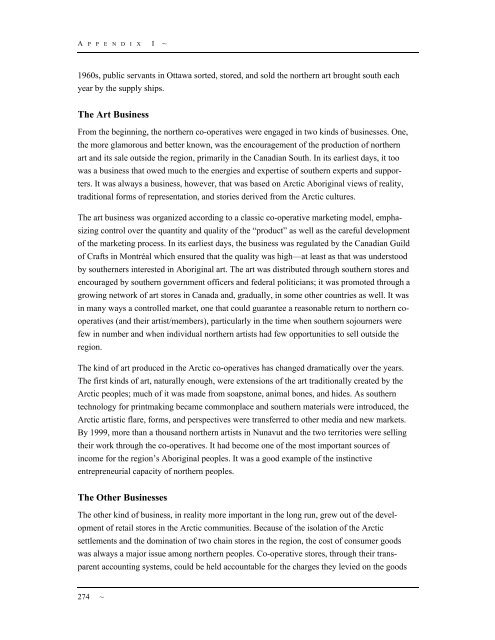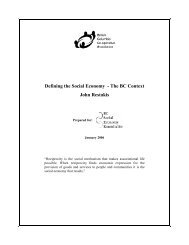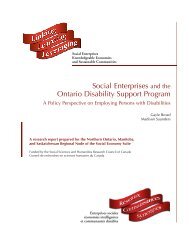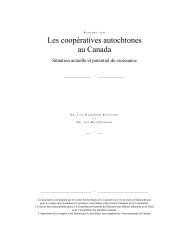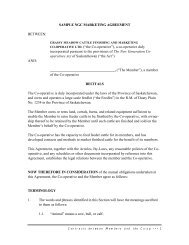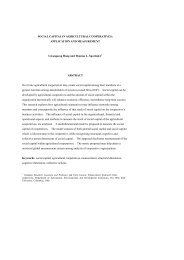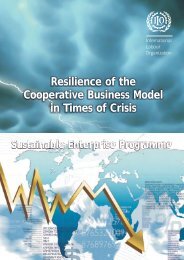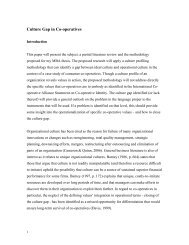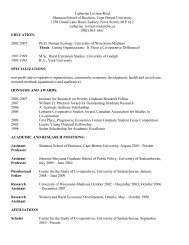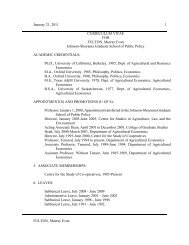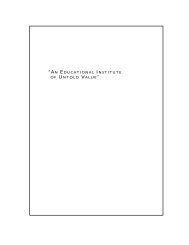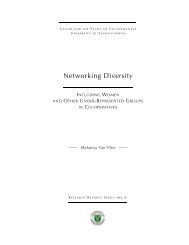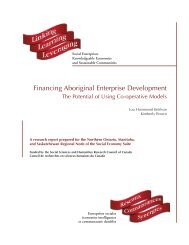Aboriginal Co-operatives in Canada - Centre for the Study of Co ...
Aboriginal Co-operatives in Canada - Centre for the Study of Co ...
Aboriginal Co-operatives in Canada - Centre for the Study of Co ...
You also want an ePaper? Increase the reach of your titles
YUMPU automatically turns print PDFs into web optimized ePapers that Google loves.
A P P E N D I X I ~1960s, public servants <strong>in</strong> Ottawa sorted, stored, and sold <strong>the</strong> nor<strong>the</strong>rn art brought south eachyear by <strong>the</strong> supply ships.The Art Bus<strong>in</strong>essFrom <strong>the</strong> beg<strong>in</strong>n<strong>in</strong>g, <strong>the</strong> nor<strong>the</strong>rn co-<strong>operatives</strong> were engaged <strong>in</strong> two k<strong>in</strong>ds <strong>of</strong> bus<strong>in</strong>esses. One,<strong>the</strong> more glamorous and better known, was <strong>the</strong> encouragement <strong>of</strong> <strong>the</strong> production <strong>of</strong> nor<strong>the</strong>rnart and its sale outside <strong>the</strong> region, primarily <strong>in</strong> <strong>the</strong> Canadian South. In its earliest days, it toowas a bus<strong>in</strong>ess that owed much to <strong>the</strong> energies and expertise <strong>of</strong> sou<strong>the</strong>rn experts and supporters.It was always a bus<strong>in</strong>ess, however, that was based on Arctic <strong>Aborig<strong>in</strong>al</strong> views <strong>of</strong> reality,traditional <strong>for</strong>ms <strong>of</strong> representation, and stories derived from <strong>the</strong> Arctic cultures.The art bus<strong>in</strong>ess was organized accord<strong>in</strong>g to a classic co-operative market<strong>in</strong>g model, emphasiz<strong>in</strong>gcontrol over <strong>the</strong> quantity and quality <strong>of</strong> <strong>the</strong> “product” as well as <strong>the</strong> careful development<strong>of</strong> <strong>the</strong> market<strong>in</strong>g process. In its earliest days, <strong>the</strong> bus<strong>in</strong>ess was regulated by <strong>the</strong> Canadian Guild<strong>of</strong> Crafts <strong>in</strong> Montréal which ensured that <strong>the</strong> quality was high—at least as that was understoodby sou<strong>the</strong>rners <strong>in</strong>terested <strong>in</strong> <strong>Aborig<strong>in</strong>al</strong> art. The art was distributed through sou<strong>the</strong>rn stores andencouraged by sou<strong>the</strong>rn government <strong>of</strong>ficers and federal politicians; it was promoted through agrow<strong>in</strong>g network <strong>of</strong> art stores <strong>in</strong> <strong>Canada</strong> and, gradually, <strong>in</strong> some o<strong>the</strong>r countries as well. It was<strong>in</strong> many ways a controlled market, one that could guarantee a reasonable return to nor<strong>the</strong>rn co<strong>operatives</strong>(and <strong>the</strong>ir artist/members), particularly <strong>in</strong> <strong>the</strong> time when sou<strong>the</strong>rn sojourners werefew <strong>in</strong> number and when <strong>in</strong>dividual nor<strong>the</strong>rn artists had few opportunities to sell outside <strong>the</strong>region.The k<strong>in</strong>d <strong>of</strong> art produced <strong>in</strong> <strong>the</strong> Arctic co-<strong>operatives</strong> has changed dramatically over <strong>the</strong> years.The first k<strong>in</strong>ds <strong>of</strong> art, naturally enough, were extensions <strong>of</strong> <strong>the</strong> art traditionally created by <strong>the</strong>Arctic peoples; much <strong>of</strong> it was made from soapstone, animal bones, and hides. As sou<strong>the</strong>rntechnology <strong>for</strong> pr<strong>in</strong>tmak<strong>in</strong>g became commonplace and sou<strong>the</strong>rn materials were <strong>in</strong>troduced, <strong>the</strong>Arctic artistic flare, <strong>for</strong>ms, and perspectives were transferred to o<strong>the</strong>r media and new markets.By 1999, more than a thousand nor<strong>the</strong>rn artists <strong>in</strong> Nunavut and <strong>the</strong> two territories were sell<strong>in</strong>g<strong>the</strong>ir work through <strong>the</strong> co-<strong>operatives</strong>. It had become one <strong>of</strong> <strong>the</strong> most important sources <strong>of</strong><strong>in</strong>come <strong>for</strong> <strong>the</strong> region’s <strong>Aborig<strong>in</strong>al</strong> peoples. It was a good example <strong>of</strong> <strong>the</strong> <strong>in</strong>st<strong>in</strong>ctiveentrepreneurial capacity <strong>of</strong> nor<strong>the</strong>rn peoples.The O<strong>the</strong>r Bus<strong>in</strong>essesThe o<strong>the</strong>r k<strong>in</strong>d <strong>of</strong> bus<strong>in</strong>ess, <strong>in</strong> reality more important <strong>in</strong> <strong>the</strong> long run, grew out <strong>of</strong> <strong>the</strong> development<strong>of</strong> retail stores <strong>in</strong> <strong>the</strong> Arctic communities. Because <strong>of</strong> <strong>the</strong> isolation <strong>of</strong> <strong>the</strong> Arcticsettlements and <strong>the</strong> dom<strong>in</strong>ation <strong>of</strong> two cha<strong>in</strong> stores <strong>in</strong> <strong>the</strong> region, <strong>the</strong> cost <strong>of</strong> consumer goodswas always a major issue among nor<strong>the</strong>rn peoples. <strong>Co</strong>-operative stores, through <strong>the</strong>ir transparentaccount<strong>in</strong>g systems, could be held accountable <strong>for</strong> <strong>the</strong> charges <strong>the</strong>y levied on <strong>the</strong> goods274 ~


